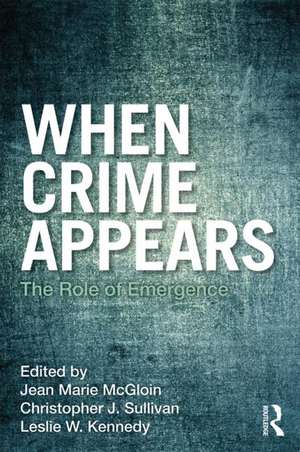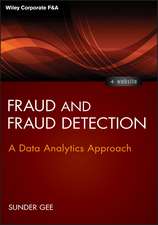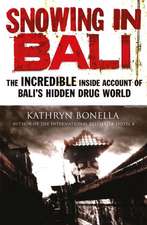When Crime Appears: The Role of Emergence: Criminology and Justice Studies
Editat de Jean McGloin, Christopher Sullivan, Leslie Kennedyen Limba Engleză Paperback – 19 oct 2011
| Toate formatele și edițiile | Preț | Express |
|---|---|---|
| Paperback (1) | 485.40 lei 6-8 săpt. | |
| Taylor & Francis – 19 oct 2011 | 485.40 lei 6-8 săpt. | |
| Hardback (1) | 1116.02 lei 6-8 săpt. | |
| Taylor & Francis – 19 oct 2011 | 1116.02 lei 6-8 săpt. |
Din seria Criminology and Justice Studies
- 15%
 Preț: 582.24 lei
Preț: 582.24 lei -
 Preț: 311.41 lei
Preț: 311.41 lei -
 Preț: 142.53 lei
Preț: 142.53 lei - 8%
 Preț: 391.95 lei
Preț: 391.95 lei - 8%
 Preț: 488.23 lei
Preț: 488.23 lei -
 Preț: 125.78 lei
Preț: 125.78 lei - 9%
 Preț: 612.78 lei
Preț: 612.78 lei - 8%
 Preț: 418.19 lei
Preț: 418.19 lei -
 Preț: 453.84 lei
Preț: 453.84 lei -
 Preț: 349.80 lei
Preț: 349.80 lei -
 Preț: 340.85 lei
Preț: 340.85 lei - 18%
 Preț: 1000.27 lei
Preț: 1000.27 lei - 15%
 Preț: 542.51 lei
Preț: 542.51 lei -
 Preț: 465.39 lei
Preț: 465.39 lei - 15%
 Preț: 575.63 lei
Preț: 575.63 lei - 22%
 Preț: 459.60 lei
Preț: 459.60 lei -
 Preț: 309.27 lei
Preț: 309.27 lei - 22%
 Preț: 431.22 lei
Preț: 431.22 lei - 5%
 Preț: 481.73 lei
Preț: 481.73 lei - 21%
 Preț: 420.66 lei
Preț: 420.66 lei -
 Preț: 449.72 lei
Preț: 449.72 lei - 18%
 Preț: 1116.02 lei
Preț: 1116.02 lei - 23%
 Preț: 327.80 lei
Preț: 327.80 lei -
 Preț: 351.80 lei
Preț: 351.80 lei - 15%
 Preț: 624.48 lei
Preț: 624.48 lei - 15%
 Preț: 576.00 lei
Preț: 576.00 lei - 18%
 Preț: 808.08 lei
Preț: 808.08 lei -
 Preț: 382.91 lei
Preț: 382.91 lei
Preț: 485.40 lei
Nou
Puncte Express: 728
Preț estimativ în valută:
92.89€ • 95.96$ • 77.31£
92.89€ • 95.96$ • 77.31£
Carte tipărită la comandă
Livrare economică 25 martie-08 aprilie
Preluare comenzi: 021 569.72.76
Specificații
ISBN-13: 9780415883054
ISBN-10: 0415883059
Pagini: 264
Ilustrații: 4 tables, 46 line drawings and Following Segregation which is Medium template
Dimensiuni: 152 x 229 x 15 mm
Greutate: 0.36 kg
Ediția:1
Editura: Taylor & Francis
Colecția Routledge
Seria Criminology and Justice Studies
Locul publicării:Oxford, United Kingdom
ISBN-10: 0415883059
Pagini: 264
Ilustrații: 4 tables, 46 line drawings and Following Segregation which is Medium template
Dimensiuni: 152 x 229 x 15 mm
Greutate: 0.36 kg
Ediția:1
Editura: Taylor & Francis
Colecția Routledge
Seria Criminology and Justice Studies
Locul publicării:Oxford, United Kingdom
Cuprins
Part 1: Introduction 1. Moving Past the Person or the Context: Thinking About Crime as an Emergent Phenomenon Christopher Sullivan, Jean Marie McGloin, and Leslie Kennedy Part 2: Explaining Crime 2. What is Emergence? R. Keith Sawyer 3. Going Back to the Beginning: Crime as a Process Travis Pratt and Jillian Turanovic 4. Does Everything Matter? Addressing the Problem of Causation and Explanation in the Study of Crime P.O. Wikstrom 5. Crime Emergence P. Jeffrey Brantingham and Martin B. Short Part 3. Crime Emergence in Action 6. Individual and Situational Risk in the Emergence of Violent Events Among Youths on the Street Stephen Baron 7. Predatory Routines and Games Elizabeth Griffiths, Jessica M. Grosholz and Lesley Watson 8. The Emergence of Violence in Drug Market Settings Angela Taylor and Deanna Wilkinson 9. Risk Terrains and Crime Emergence Leslie W. Kennedy and Joel Caplan 10. Crime Emergence and Criminal Careers Tara Renae McGee and Alexis R. Piquero Part 4: Studying Crime Emergence 11. Crime Emergence and Simulation Modeling. Modeling Crime Space Patricia Brantingham, Kathryn Wuschke, Richard Frank and Paul Brantingham 12. Measuring and Analyzing the Emergence of Crime Christopher Sullivan
Recenzii
"This book is an extremely welcome and useful effort to move criminology off its baroque methods testing moribund theories. It contains a diverse group of notably innovative authors who clearly demonstrate the range of applications emergent thinking can influence. Anyone who is a serious scholar of crime should read it."—John Eck, Criminal Justice, University of Cincinnati
"It is vital to explain both the development of potential offenders and the occurrence of criminal events, and how individuals and environments interact to produce crimes. This book bravely addresses these fundamental issues with a new "emergence" theory. and it should be required reading for anyone who is interested in criminological theories."—David Farrington, Criminology, Cambridge University
"This edited volume, geared to crime and criminology scholars, provides an orienting overview of and an invitation to the emergence perspective. Chapters highlight ways the framework builds upon but also extends interactionist, situational and transactional frameworks. The work provides a valuable alternative to current person-based and place-based crime meta-models."—Ralph B. Taylor, Criminal Justice, Temple University
"When Crime Appears is an important book that pushes criminologists to look deeper into the causal patterns underlying crime and criminality."—David L. Weisburd, Criminology, Law and Society, George Mason University
"It is vital to explain both the development of potential offenders and the occurrence of criminal events, and how individuals and environments interact to produce crimes. This book bravely addresses these fundamental issues with a new "emergence" theory. and it should be required reading for anyone who is interested in criminological theories."—David Farrington, Criminology, Cambridge University
"This edited volume, geared to crime and criminology scholars, provides an orienting overview of and an invitation to the emergence perspective. Chapters highlight ways the framework builds upon but also extends interactionist, situational and transactional frameworks. The work provides a valuable alternative to current person-based and place-based crime meta-models."—Ralph B. Taylor, Criminal Justice, Temple University
"When Crime Appears is an important book that pushes criminologists to look deeper into the causal patterns underlying crime and criminality."—David L. Weisburd, Criminology, Law and Society, George Mason University
Notă biografică
Jean Marie McGloin is an Associate Professor in the Department of Criminology and Criminal Justice at the University of Maryland. She received her Ph.D. from the School of Criminal Justice at Rutgers University-Newark in 2004. Her research primarily focuses on groups and crime and offending specialization. Her recent publications have appeared in Criminology, the Journal of Research in Crime and Delinquency, and the Journal of Quantitative Criminology.
Christopher J. Sullivan is an Assistant Professor in the School of Criminal Justice at the University of Cincinnati. He received a doctorate from Rutgers University's School of Criminal Justice in 2005. His research interests include developmental criminology; juvenile delinquency and prevention policy; and research methodology and analytic methods. His recent work has appeared in Criminology, Prevention Science, Journal of Research in Crime and Delinquency, Journal of Youth and Adolescence, Journal of Quantitative Criminology, and Criminal Justice and Behavior.
Leslie W. Kennedy is University Professor of Criminal Justice at Rutgers University -Newark. He is also the Director of the Rutgers Center on Public Security. Dr. Kennedy’s current research in public security builds upon his previous research in event analysis and understanding the social contexts in which hazards to society are identified and deterred.
Christopher J. Sullivan is an Assistant Professor in the School of Criminal Justice at the University of Cincinnati. He received a doctorate from Rutgers University's School of Criminal Justice in 2005. His research interests include developmental criminology; juvenile delinquency and prevention policy; and research methodology and analytic methods. His recent work has appeared in Criminology, Prevention Science, Journal of Research in Crime and Delinquency, Journal of Youth and Adolescence, Journal of Quantitative Criminology, and Criminal Justice and Behavior.
Leslie W. Kennedy is University Professor of Criminal Justice at Rutgers University -Newark. He is also the Director of the Rutgers Center on Public Security. Dr. Kennedy’s current research in public security builds upon his previous research in event analysis and understanding the social contexts in which hazards to society are identified and deterred.
Descriere
This book brings together work from a unique conceptual perspective that helps to better understand the complex relationships that give rise to crime.











